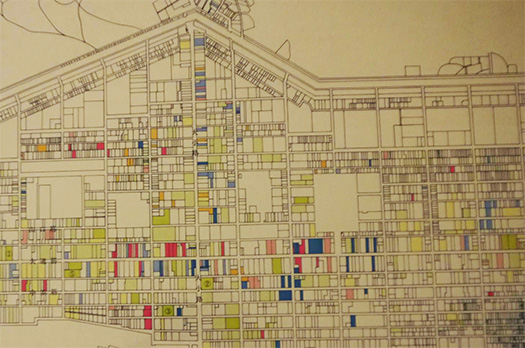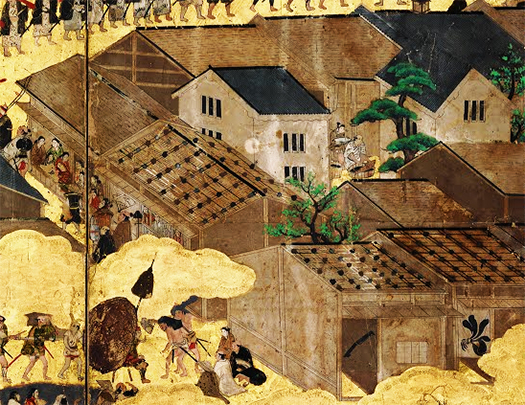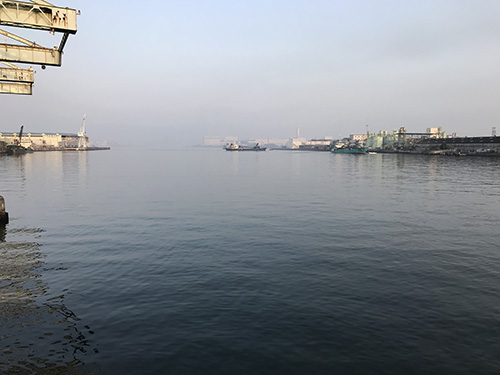

堺という街は仁徳天皇陵を大きなランドマークとして成立したと思います。
実在が確実な大王としての仁徳の陵墓をこの大阪湾の海岸線のやや高台に
建設した目的は、司馬遼太郎さんのコラムなどにあるように、
大陸からの来訪者に対してこの列島国家の巨大さをメッセージすることだったとされる。
逆に言えばそれだけ東アジア世界では中国国家との対応は難しかったのでしょう。
政治経済的・地政学的に伝統的に日本は中国との関係性を悩んできた。
聖徳太子の「日出ずる国の・・・」という外交ぶりなど瀬戸際で常に苦闘し続けてきた。
その最初期のものとしてこの仁徳天皇陵はあったと思います。
はじめは石で陵を被覆してあったということなので、
大阪湾を望んで住吉・住之江か、堺の湊を目指す船中から陵墓がどう見えるか、
それによって中国の外交使者がどう印象するかは非常に大きなポイントだっただろう。
こうしたさまざまな努力の甲斐があって、中国国家は日本に対して
ちょうどインドに対するかのようなある程度慎重な扱いが常だったとされる。
そうでなければそもそも「日本」などという国号を認証しなかっただろう。
日の本の国、という国名には華夷思想へのアンチテーゼが含意されている。
そういう文脈の中に今日の対中関係もあると思える。
いまは華夷思想でしか国を統御できない権力中枢が支配しているので
こういう時期は慎重に対応していく必要がある。
中国自身も権力には波動があるので、強権からのトーンダウンも見る必要がある。
東アジア国際関係の知恵の蓄積が日本にはあると思う。

・・・という時代から、西欧諸国ポルトガルやスペインなどの大航海時代。
巨大すぎる中国とどう向き合い、どう侵略すべきかとかれらも探っていたに違いない
これら諸国にとって戦国から江戸の時代、畿内地域の玄関口としての堺の湊は
アジア進出の橋頭堡的な位置付けで考えていたに違いない。
日本に対してこれら諸国はどう利活用を考えていたか、よく知りたい。
かれらにとっては日本の地政学的位置は魅力的だったのでしょうね。
やがて日本はこの屏風絵の時期を経て鎖国に向かうのだけれど、
鉄砲技術の導入以降、日本は脱東アジアという国際的視点を持つことができた。
上の図は堺市博物館展示の江戸初期の「町割り図」。
整然とした町割り・都市計画が明瞭で中世以来の自治伝統の実態を目にする思い。
住吉大社祭礼時にはこうした主要街路を多くの人がパレードした。
屏風絵の詳細図は町割りのひとつの区割りをクローズアップした。
通りに面して木造の店舗建築が並び、区割りの内側には漆喰で塗り固めたとおぼしき
倉庫群が見えている。大航海時代と日本社会が出会って
交易活動が活発化して日本的商家のありようのスタンダードもできたのでしょうか。
信長が持っていたような感受性の目でこの時代の町並みを歩いてみたい。
いまなにが流行っているのか、人々はなにを求めているのか、
最先端の国際交易都市の街を構成するビジネスから変化する時代意識を
たっぷりと吸収していたに違いないと思いますね。
English version↓
[City division of medieval commercial city / Japanese good house special edition ㊱-6]
I think the city of Sakai was established with the Emperor Nintoku Mausoleum as a major landmark.
The tomb of Nintoku as a real king is on a slightly higher ground along the coastline of Osaka Bay.
The purpose of the construction is as shown in Ryotaro Shiba’s column.
It is said that it was to message visitors from the continent about the hugeness of this archipelago nation.
To put it the other way around, it would have been difficult to deal with the Chinese state in the East Asian world.
Traditionally, politically, economically and geopolitically, Japan has been worried about its relationship with China.
Prince Shotoku has always struggled on the brink, such as the diplomacy of “The Land of the Rising Sun …”.
I think there was this Nintoku Emperor’s Mausoleum as the earliest one.
At first, the tomb was covered with stone, so
What does the tomb look like from the ship aiming for Sumiyoshi / Suminoe overlooking Osaka Bay or Minato in Sakai?
How the Chinese diplomatic messenger would be impressed by this would have been a very big point.
Thanks to these various efforts, the Chinese state is against Japan.
It is said that he was always treated with some caution as if he were dealing with India.
Otherwise, it would not have certified a country name such as “Japan” in the first place.
The name of the country of the book of Japan implies an antithesis to the Sinocentrism.
It seems that today’s relationship with China is also in that context.
Nowadays, the power center, which can control the country only by the Sinocentrism, is in control.
It is necessary to deal with such times carefully.
Since China itself has a wave of power, it is necessary to see the tone down from the power.
I think Japan has an accumulation of wisdom on East Asian international affairs.
From the era of … to the Age of Discovery in Western European countries such as Portugal and Spain.
They must have been searching for how to face China, which is too big, and how to invade it.
For these countries, Sakai Minato as the gateway to the Kinai region during the Warring States to Edo period
It must have been considered as a bridgehead for expanding into Asia.
I would like to know well how these countries were thinking about utilizing Japan.
Perhaps Japan’s geopolitical position was attractive to them.
Eventually, Japan heads for seclusion after this folding screen painting period,
Since the introduction of gun technology, Japan has been able to have an international perspective of de-East Asia.
The figure above is the “town division map” of the early Edo period exhibited at the Sakai City Museum.
The orderly division of towns and city planning are clear, and I want to see the reality of the autonomy tradition since the Middle Ages.
Many people paraded on these main streets during the Sumiyoshi Taisha Festival.
The detailed drawing of the folding screen is a close-up of one of the town divisions.
Wooden store buildings are lined up facing the street, and it seems that the inside of the division was plastered.
You can see the warehouses. The Age of Discovery meets Japanese society
Did trading activities become more active and set the standard for Japanese merchants?
I want to walk the streets of this era with the sensitivity that Nobunaga had.
What is popular now, what are people looking for?
A changing consciousness of the times from the businesses that make up the state-of-the-art international trading city
I think it must have been absorbed a lot.
Posted on 7月 11th, 2021 by 三木 奎吾
Filed under: 「都市の快適」研究, 住宅マーケティング







コメントを投稿
「※誹謗中傷や、悪意のある書き込み、営利目的などのコメントを防ぐために、投稿された全てのコメントは一時的に保留されますのでご了承ください。」
You must be logged in to post a comment.